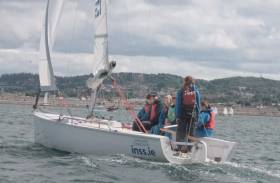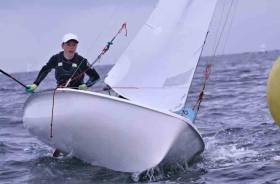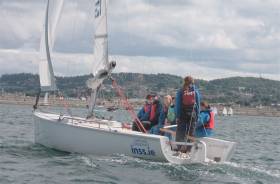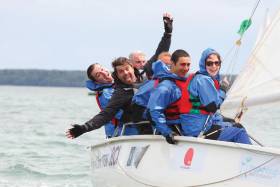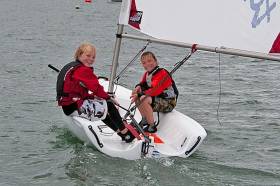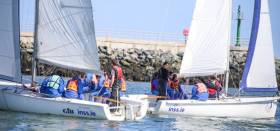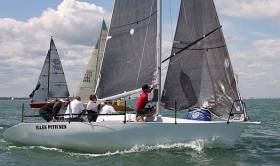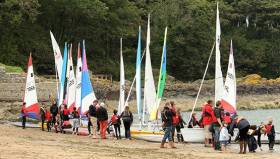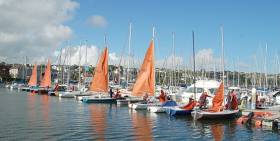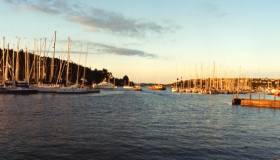Displaying items by tag: Try Sailing
Children’s Summer Sailing Courses With The INSS
#TrySailing - Summer sailing courses for children aged 4 to 17 are available to book now at the Irish National Sailing & Powerboat School in Dun Laoghaire.
The 2017 summer courses, which begin next Tuesday 6 June, will see students assigned to groups according to their age (4-6 years, 7-10 years, 11-14 years and 15-18 years) and experience.
All essential gear is provided, from boats to buoyancy aids, while wetsuits can be hired by the week.
This year sees two new programmes running alongside the summer sailing courses: sailing through the Irish language for 11-14-year-olds and a keelboat programme providing a different challenge for teens 15 and over.
Click HERE for full details of the INSS summer sailing course programme and how to book.
#TrySailing - No boat is required nor previous sailing experience necessary for teenagers who want to try sailing with the National Yacht Club this summer.
Two introductory courses will run from 6-16 June and 10-21 July in Dun Laoghaire specifically for teenagers who would like to try sailing but don’t want to learn among a group of much younger children.
Interested teens will be sailing with other beginner sailors of a similar age in groups of three to four using club boats, making for a great introduction to the sport in a fun and social environment.
#TrySailing - Sunday 14 May is the date for the Irish National Sailing & Powerboat School’s 2017 Open Day — where anyone can try sailing, kayaking or paddleboarding at Dun Laoghaire Harbour for only €10.
All ages are welcome on the day, whether families, friends or individuals, for what promises to be an exciting day on the water — coinciding with the annual Sail-a-thon charity event organised by sailors attending the INSS junior club sailing programme.
Whether you’re entirely new to the sport or rekindling an old flame, you’ll be learning how to sail on board one of the school’s fleet of 1720 sportsyachts — waterproof overalls and lifejackets provided!
Those interested in kayaking and paddleboarding, meanwhile, will be guided around the sheltered waters inside Dun Laoghaire Harbour to give a taste of what makes these activities so appealing.
Details on booking a session for the day can be found on the INSS website HERE.
Try Sailing - Here, There, Everywhere
Looking back over the past season, two things stand out for me – the success of our Olympic sailors and the ISA’s Try Sailing initiative. Our Olympic sailors gave us marvellous inspiration this summer and showed our young sailors what can be achieved if you follow your dream and no doubt encouraged many newcomers to discover the thrill of sailing for the first time. My next blog will focus on our Olympians but, for the moment, I want to reflect on the success of the ISA Try Sailing initiative over the past season. 66 ISA clubs and centres throughout the country created new opportunities for local communities to come along and Try Sailing and, as a result, over 3,600 people tried sailing. A great achievement.
If you are not from a sailing background it can be hard to know where and how to start, and buying a boat before you have given it a try is a tall order. The simple message of “Try Sailing” is to help promote the idea that people can do just that – give Sailing a Try.
At those 66 venues there were open days, competitions, crewing initiatives, tasters, corporate programmes, Women on the Water events, Surf ‘n’ Turf days, cruises, Sailability events, kids’ clubs, bring a friend and more. It was wonderful to see each organisation running events and programmes to suit their own facilities and local community. Below I have set out just a few examples of the dedicated effort and creative activities of a handful of the clubs in 2016.
Try Sailing 2016 kicked off with an open day at Kinsale Yacht Club for local school children and an introduction to the Sailability opportunities for all physical abilities at the club. It was a blustery day and the strong team of volunteers adapted the activities for everyone with cruiser sailing, Sailability Squib sailing and rigging games. The club followed up with a series of coaching days for the young sailors throughout the season and successfully saw an increase in club training and membership.
Just around the corner, Royal Cork Yacht Club had a particularly busy year under the Try Sailing banner. Colin Morehead, Try Sailing ambassador at Royal Cork and ISA policy group member, says they have had their busiest year yet. Their Try Sailing all started in May with the annual 6-week introduction to youth sailing programme with 80+ children participating.
The club then organised an 8-week training programme with 45 sailors from a large Cork based company, Voxpro, and developed a winning team to race in the Non-Spinnaker Class of Volvo Cork Week. It was particularly satisfying to see complete novices grow into sailors capable of successfully racing a 1720 sports boat in such a short time.
Combined with a highly successful Open Day in June, a very popular Women on the Water programme and Try Sailing sessions for adults, Royal Cork Yacht Club opened the doors to over 250 new Try Sailors.
Meanwhile over on the West coast, Foynes Yacht Club went for a gentle approach to attract new crews for cruiser racing. Club members brought newcomers out on the water to simply observe the racing and gain a basic understanding of what all the activity was about. This soft approach worked well in giving newcomers confidence to get on board and participate in cruiser racing. The ICRA ‘Crew Point’ initiative launched this year will continue to help to create many more new crewing opportunities throughout the country.
Foynes Yacht Club Junior Organiser Elaine O’Mahoney was delighted with the turn out when they linked up with the local youth clubs and transition year students for Try Sailing. Elaine tells me that a dedicated time slot for visitors to come and try, helped locals to make sailing part of their weekly routine. Overall, Foynes Yacht Club registered over 200 Try Sailors and are pleased to see the number of new members, sailing academy trainees and racing crews increasing.
Dingle Sailing Club introduced a clever “Bring a Friend” programme and doubled their participation numbers. Training Manager Feidhlim OBriain says he saw immediate results from their initial Try Sailing open day and then continued to use the Try Sailing branding to promote a series of Try opportunities, bringing a total of over 170 Try Sailors onto the water.
Galway Bay Sailing Club launched Try Sailing with an early season open day and saw an immediate impact on courses and membership for dinghy and cruiser sailors. They followed their open day with a 5 week Try Sailing coaching programme for adults, which then grew into a series of start sailing adult courses. 152 Try Sailors brought an increase in membership, training and crewing. The club are now making plans for a new ‘Women on the Water’ programme for 2017.
Clontarf Yacht and Boat Club’s ‘Sail Against Suicide’ provided a chance to Try Sailing with a typical Clontarf welcome in the clubhouse afterwards. Combined with earlier corporate and public events Clontarf registered 98 Try Sailors in dinghies and cruisers and have big plans for 2017.
Overall, the message of Try Sailing is helping to open the doors, hatches and pontoons to more newcomers to our wonderful sport. So, next time you are getting on board, remember “Bring a Friend” and give them the chance to “Try Sailing”.
Our Regional Development Officers look forward to helping your club implement its Try Sailing plans and together we can grow the number of people enjoying the delights of sailing.
Happy Christmas and safe sailing in 2017.
Places Available For 2017 ISA Sailing Courses At Baltimore SC
#TrySailing - Baltimore Sailing Club is now taking bookings for places on its 2017 ISA summer sailing courses.
The first course runs over three weeks from Monday 3 to Friday 21 July, while a second three-week course runs the following month from Tuesday 8 to Friday 25 August.
In addition, a Junior Try Sailing Taster Course runs from Monday 24 to Friday 28 July comprising two half-day courses each day.
Application forms are available on the Baltimore SC website HERE.
Last Sunday, Dun Laoghaire's Irish National Sailing and Powerboat School held its 2016 Open Day in association with Irish Sailing Association's 'Try Sailing' programme.
50 new people to the sport experienced the thrill of sailing onboard a 1720 sportsboat while 64 people enjoyed kayaking and Paddle-Boarding. Check out the video below:
The inaugural ISA 'Try Sailing' Invitational will take place this July, hosted by the Royal Cork Yacht Club (RCYC), Crosshaven, Co. Cork, as part of Volvo Cork Week from July 10th to 15th. It represents one of a number of initiatives under the ISA’s Try Sailing banner aimed at introducing as many people as possible to the joys of sailing.
“It is with huge excitement that we announce the inaugural ISA Try Sailing Invitational which will be part of Volvo Cork Week 2016. This event will attract teams from clubs across the country and will add a unique and exciting element to the already fun packed Volvo Cork Week 2016.” – Kieran O’Connell, Chairman of Volvo Cork Week.
The ISA Try Sailing Invitational invites sailing clubs from around the country to put together a team comprised of participants in their Try Sailing programmes. Each club can nominate one experienced sailor to either skipper their entry or be part of the crew. Racing will take place in 1720 sports boats, over five days, with challenging and enjoyable inshore racing. Teams will get the chance to enjoy the renowned social experience of Volvo Cork Week and the winning team will win the ISA Try Sailing Invitational Trophy.
This event will develop valuable bonds between Try Sailing participants and the clubs they represent and will give them an appreciation for what a large regatta is all about – play, sail & enjoy. The ISA Try Sailing Invitational represents a fantastic opportunity to further enhance participation in the sport of sailing through racing in the natural maritime amphitheatre that is Cork Harbour – the largest natural harbour in the northern hemisphere.
The Irish Quarter Ton Cup will also be held at Volvo Cork Week 2016. In the 1980's and 90's the then J Class raced every week in the RCYC and was made up of many different quarter tonners so many people got their first experience of sailing in a quarter tonner. The Irish Quarter Ton Cup in 2016 will not only crown a national champion but the winner will also be eligible for a class European Medal and will be in with a chance to win best overall boat of the European Championship. Volvo Cork Week 2016 is looking forward to welcoming quarter tonners from all over Ireland and the UK to compete this year.
There was a time when the local sailing club was a social centre for children, where they got their first ‘taste’ of sailing as a ‘fun’ and enjoyable occasion without the stress of competition and performance separating them from each other, based on their “sporting prowess.”
In the past few weeks I have learned from readers and listeners who have contacted me that there is more than one aspect of exclusivity about sailing and my opening description this week is compiled from what I have been told since I first expressed concern that the public perception of elitism in sailing may be excluding a wider coterie of people from participation in the sport.
The Irish Sailing Association has responded with the launch of the ‘Try Sailing Programme’ and a number of clubs have introduced Crew Point’ for newcomers to be introduced to the sport, which are positive initiatives, but ‘sailor/parents’ have referred me to their concerns that representative “squads” and “teams” lauded by clubs can deter youngsters who do not reach the perceived sporting parameters from continuing in the sport..
There is a dichotomy between the desire of clubs to be well represented nationally, which builds their reputations and similarly, for Ireland to do the same at international level, which necessitates identifying and developing high performers. Sailing is not the only sport needing the sustenance of success, but what about maintaining the interest of those who do not aspire to or succeed at the higher levels? Clubs are not founded on the success of “squads,” or “teams” or individual “stars” but on strong committed ‘ordinary’ members, the foundation for the future.
The Vice-Commodore of Royal North of Ireland Yacht Club, based at Holywood, Co.Down, is Michael Meharg, who has been telling me about the development of the concept of the ‘Regatta Club’ on Belfast Lough, mixing fun, the sociability of sailing and a gentle introduction to racing for young sailors, while at the same time increasing club membership, participation and introducing newcomers to the sport:
“You are probably aware of the RYA's "Push the Boat Out" initiative, encouraging "come and try it" days at the various yacht clubs? My club, RNIYC, has been running these days for the last five years with good results. We are holding our next one on May 22.”
He went on to tell me of a bigger concept, currently being launched, called ‘Regatta Club’ with a focus on young sailors. Michael is an RYA Senior Instructor with 30 years’ experience of training children, is easy to listen to and explains the concept well on this week’s THIS ISLAND NATION PODCAST, which you can hear below.
“As you rightly point out, a lot of organisations are racing-focussed and in my experience, many of the youngsters coming out of their first courses have neither the experience nor confidence to go straight into racing/squad training and prefer to sail for the fun and sociable side of things. If these opportunities are not there, we lose them! At the same time, Regatta attendance in Belfast Lough has been declining for some time now.”
Regatta Club’ aims to encourage youngsters from 8-to-18 years into "sociable sailing” and, perhaps, return to those days when children loved to go down to ‘the club’ to go sailing and the sport captured their lifetime interest as a result. Saturday, June 4, off Grey Point in Helen’s Bay, is the inaugural event and there is an open invitation to Afloat readers.
- Listen to the podcast below.
ISA Tries To Get Rid Of Elitism In Sailing
I have been vocal over the past few months in expressing concern about improving access to sailing and combating the impression that the sport is elitist. I spoke about the need for initiatives at the annual conference of the Irish Cruiser Racing Association in Limerick and at the annual meeting of the South Coast Offshore Racing Association in Kinsale. Scroll down to listen to the podcast below.
While both are racing-focussed organisations they were the two which offered an opportunity to raise the subject and credit to them for doing so. Both meetings acknowledged the need for increasing recruitment into the sport and the difficulties experienced in many clubs of holding onto members and crewing cruisers for racing. And issues were raised as to whether clubs and boat owners were sufficiently welcoming to potential newcomers, whether the cost of memberships was too high and whether there was too much emphasis on racing and the ‘fun’ element of the sport had been lost.
There is more to sailing than the competitive aspect and more also than cruiser racing. However, dinghy fleets, while having less of a ‘numbers’ requirement to sail boats, have also been experiencing the need to ensure their future and they share a common desire to increase club memberships and active sailors.
So I am glad to see the response of the Irish Sailing Association in the launching of the TRY SAILING programme. The official launch will be on Monday next, Bank Holiday Monday in Kinsale Yacht Club in Co.Cork at 1p.m. where a number of schools and groups with disabilities from the local area are going to do a ‘try sailing’ session.
Ciaran Murphy, the ISA Regional Development Officer, specialising in Access and Participation, is leading the Try Sailing initiative. He was Manager of Lough Derg Yacht Club before joining the Irish Sailing Association. On this week’s THIS ISLAND NATION PODCAST, I discuss its purpose, where and how it will be implemented and whether it will eradicate that impression of elitism.
There may be some expense involved in training programmes, but at a low cost and there are other opportunities being offered alongside TRY SAILING, such as the CREW POINT which a number of clubs have committed to trying this season to encourage potential newcomers to approach clubs directly on sailing days and evenings.
Combined, these are encouraging new approaches to increasing interest in sailing.
CIT's Cool Route Project Invites Alumni To Try Sailing
#CoolRoute - Cork Institute of Technology (CIT) is inviting alumni and friends – especially those with no previous experience – to 'Try Sailing' at a yacht club near you.
The drive comes from a partnership between CIT, the Royal Cork Yacht Club and the Irish Sailing Association and falls under the remit of CIT's Cool Route Project, which aims to attract business to peripheral locations by promoting yacht cruising on the scenic coastline of North West Europe.
Capitalising on the current big push to attract young people to sailing and cruising, 'Try Sailing' developed as a result of discussions with with ISA and RCYC via the CIT Cool Route team.
Individuals and groups alike are encouraged to head to Crosshaven – one of many other participating clubs around the coastline – to take out a 1720 class racer with an instructor for three hours, all necessary safety gear provided and no previous experience necessary.
While there is a small fee involved, there are possible group discounts for CIT alumni and friends.
For more details visit the Try Sailing website, follow the hashtag #eucoolroute on social media or visit Facebook.com/eucoolroute


























